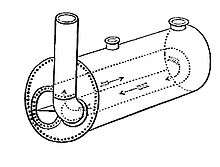List of boiler types, by manufacturer
There have been a vast number of designs of steam boiler, particularly towards the end of the 19th century when the technology was evolving rapidly. A great many of these took the names of their originators or primary manufacturers, rather than a more descriptive name. Some large manufacturers also made boilers of several types. Accordingly, it is difficult to identify their technical aspects from merely their name. This list presents these known, notable names and a brief description of their main characteristics.
See also
- Glossary of boiler terminology
A
| Definitions | Points of Interest |
|---|---|
|
.jpg) Thornycroft steam wagon boiler, an annular water-tube with inclined tubes |
B
| Definitions | Points of Interest |
|---|---|
|
.jpg) Babcock & Wilcox 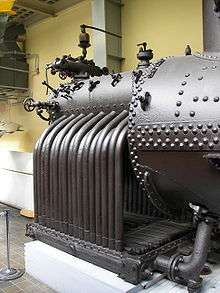 Brotan-Defner boiler firebox |
C
| Definitions | Points of Interest |
|---|---|
|
.jpg) section through a Cornish boiler .jpg) Vertical flue cross-tube boiler |
D
| Definitions | Points of Interest |
|---|---|
|
E
| Definitions | Points of Interest |
|---|---|
|
 |
F
| Definitions | Points of Interest |
|---|---|
|
|
G
| Definitions | Points of Interest |
|---|---|
|
 Galloway boiler |
H
| Definitions | Points of Interest |
|---|---|
|
|
I
| Definitions | Points of Interest |
|---|---|
|
J
| Definitions | Points of Interest |
|---|---|
|
K
| Definitions | Points of Interest |
|---|---|
| |
L
| Definitions | Points of Interest |
|---|---|
|
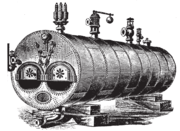 Lancashire boiler  Locomotive boiler |
M
| Definitions | Points of Interest |
|---|---|
|
.jpg) monotube boiler (White steam car) .jpg) Mumford |
N
| Definitions | Points of Interest |
|---|---|
|
|
O
| Definitions | Points of Interest |
|---|---|
|
P
| Definitions | Points of Interest |
|---|---|
|
R
| Definitions | Points of Interest |
|---|---|
|
.jpg) Robertson boiler |
S
| Definitions | Points of Interest |
|---|---|
|
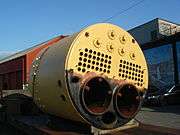 Scotch marine boiler |
T
| Definitions | Points of Interest |
|---|---|
| |
V
| Definitions | Points of Interest |
|---|---|
| |
W
| Definitions | Points of Interest |
|---|---|
| |
Y
| Definitions | Points of Interest |
|---|---|
|
.jpg) Yarrow boiler .jpg) Yorkshire steam wagon |
References
- Harris, Model Boilers, pp. 56–57.
- Harris, Model Boilers, p. 55.
- Milton, J. H. (1961) [1953]. Marine Steam Boilers (2nd ed.). Newnes. p. 60.
- Milton, Marine Steam Boilers, pp. 111-115.
- Uri Zelbstein (1987). "L'histoire d'une invention: Julien Belleville et sa chaudière à tubes d'eau". History and Technology, an International Journal (in French). 3 (2): 205–218. doi:10.1080/07341518708581667.
- Brown, David K (2010) [1997]. Warrior to Dreadnought. Chatham. p. 137. ISBN 978-1-84832-086-4.
- Milton, Marine Steam Boilers, pp. 144-145.
- Brown (1997), p. 140.
- Harris, K. N. (1974). Model Boilers and Boilermaking. MAP. pp. 58–59. ISBN 0-85242-377-2.
- Rippon, Commander P.M., RN (1998). The evolution of engineering in the Royal Navy. Vol 1: 1827-1939. Spellmount. p. 29. ISBN 0-946771-55-3.CS1 maint: ref=harv (link)
- Douglas Self. "Brotan". Loco Locomotive gallery.
- "Brotan".
- Kennedy, Modern Engines, Vol VI.
- "Clarkson Thimble Tube Boiler Co". Grace's Guide. Retrieved 10 April 2018.
- Harris, Model Boilers, pp. 58-60.
- Kennedy, Modern Engines, Vol V.
- Milton, J. H. (1961) [1953]. Marine Steam Boilers (2nd ed.). Newnes. pp. 63–66.
- Milton, Marine Steam Boilers, pp. 119–137.
- Gardner D. Hiscox (2001) [1904]. 970 Mechanical Appliances and Novelties of Construction. Algrove Publishing. p. 58. ISBN 1-894572-37-8.
- Harris, Model Boilers, pp. 160–161.
- Brown (1997), p. 165.
- Harris, Model Boilers, pp. 52–53.
- "Flaman". Loco Locomotive gallery.
- Milton, Marine Steam Boilers, pp. 138-145.
- Hewison, Boiler Explosions, p. 12.
- Harris, Model Boilers, pp. 158–160.
- Harris, Model Boilers, pp. 58–59.
- Milton, Marine Steam Boilers, p. 59.
- Harris, Model Boilers, p. 47.
- McEwen, Alan (2009). Historic Steam Boiler Explosions. Sledgehammer Engineering Press. ISBN 978-0-9532725-2-5.
- Harris, Model Boilers, pp. 60–61.
- Milton, Marine Steam Boilers, pp. 138-141.
- "German high-pressure locomotives". Loco Locomotive gallery.
- Harris, Model Boilers, pp. 150-151.
- Ahrons, E.L. (1966). The British Steam Railway Locomotive. I, to 1925. Ian Allan. p. 351.
- Harris, Model Boilers, p. 56–58.
- "Monotube steam generator". Light Steam Power. XXIV (3): 157–159. July–September 1975.
- "A. G. Mumford". Grace's Guide. Retrieved 20 March 2016.
- Kennedy, Rankin (1912). The Book of Modern Engines and Power Generators. V. London: Caxton. pp. 43–45.
- Harris, Model Boilers, p. 54.
- Harris, Model Boilers, pp. 63,65.
- Cisin, Harry G. (1921). Modern Marine Engineering. New York: Van Nostrand. p. 84.
- Robertson, Leslie S. Water-tube boilers. p. 38.
- "One Atmosphere Boiler - Superheated Steam Boiler". Micropyretics Heaters Industrial.
- Harris, Model Boilers, pp. 63–64.
- Seikan Ishigai (1999). Steam Power Engineering. Cambridge University Press. pp. 33–35. ISBN 0521135184.
- McEwen, Historic Steam Boiler Explosions.
- "Schmidt high-pressure system". Loco Locomotive gallery.
- Harris, Model Boilers, pp. 167-168.
- Harris, Model Boilers, p. 57.
- Harris, Model Boilers, pp. 169-171.
- Greenly, Henry (1922). Model Steam Locomotives. Cassell. pp. 52–56.CS1 maint: ref=harv (link)
- Milton, Marine Steam Boilers, pp. 130-132.
- Hills, Power from Steam, pp. 130–131.
- Harris, Model Boilers, p. 51.
- Milton, Marine Steam Boilers, pp. 143-144.
- Stokers Manual ((1912 edition) ed.). Admiralty, via HMSO, via Eyre & Spottiswoode. 1901.
- "Thuile". Loco Locomotive gallery.
- "Velox locomotive". Loco Locomotive gallery.
- Douglas Self. "The Colombian Steam Motor Locomotive". Loco loco gallery.
- "Sentinel locomotives & railcars". www.steamindex.com. Retrieved 10 April 2018.
- Britannica, 1911
- Hills, Power from Steam.
- Harris, Model Boilers, p. 36.
- Kennedy, Rankin (1912). The Book of Modern Engines and Power Generators. VI. London: Caxton.
- Milton, Marine Steam Boilers, pp. 108-111.
- Borthwick, Alastair (1965). Yarrows: the first hundred years. Yarrows.
This article is issued from Wikipedia. The text is licensed under Creative Commons - Attribution - Sharealike. Additional terms may apply for the media files.
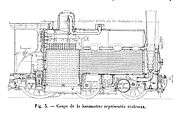
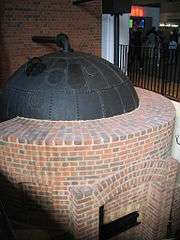
.png)
